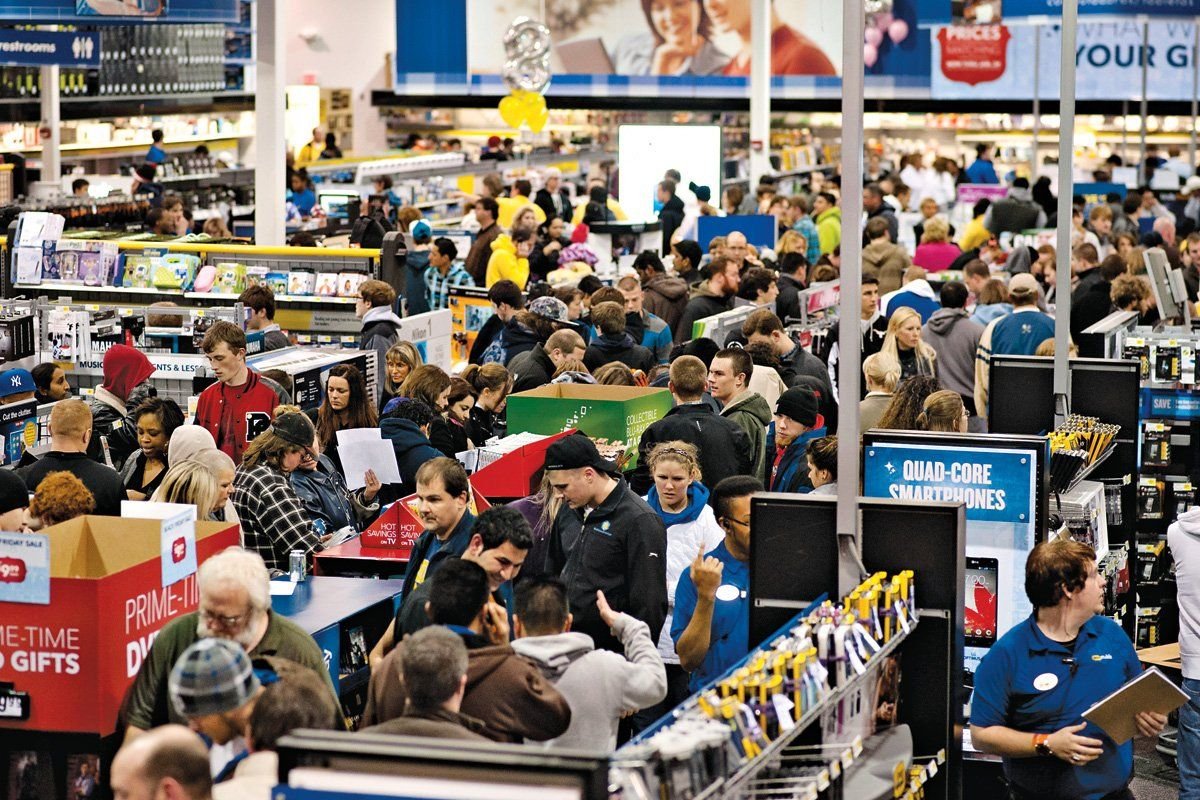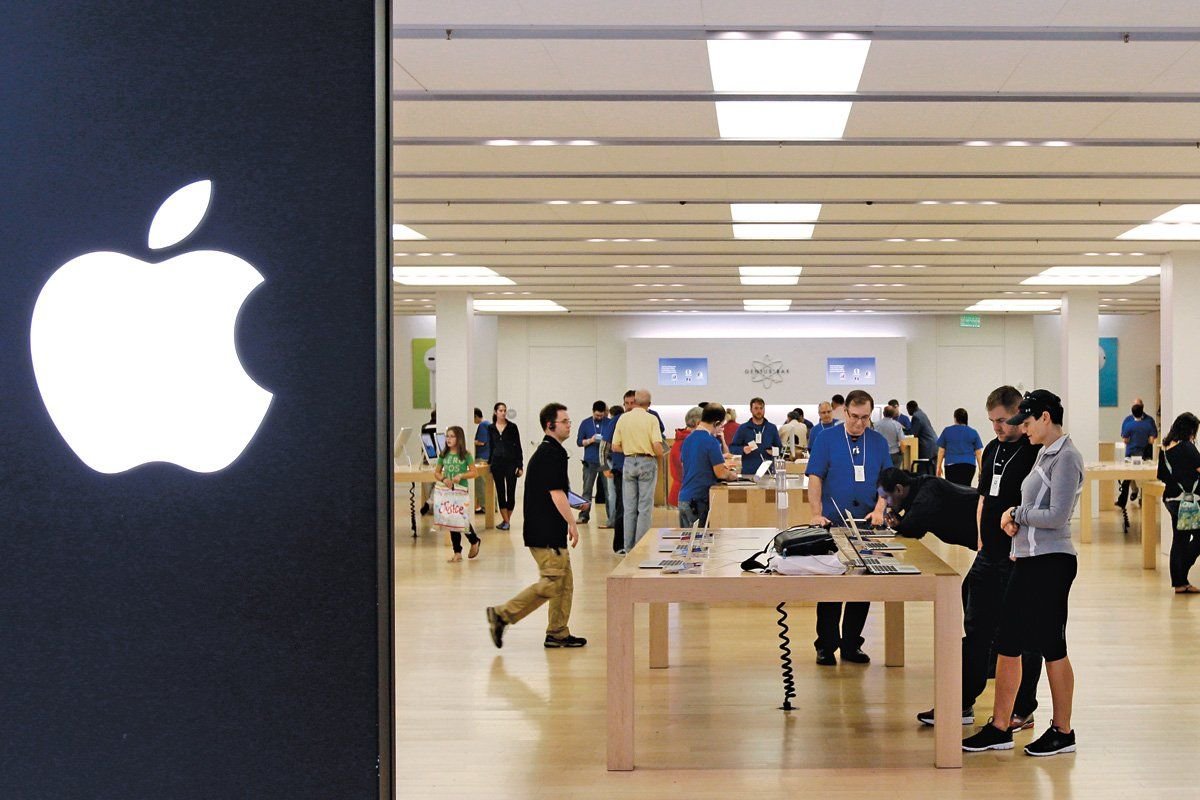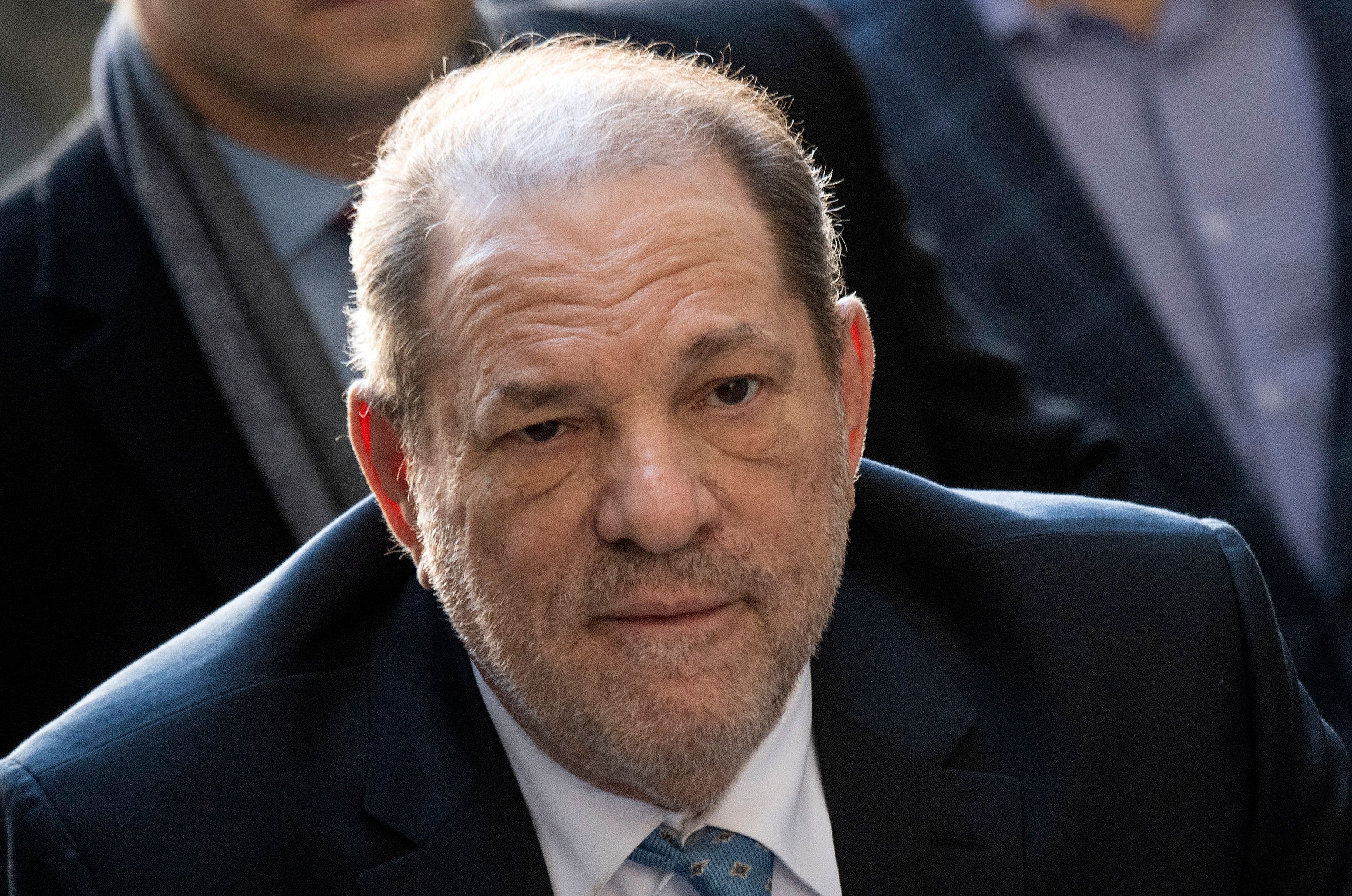
"Clearly unsatisfactory" is what Best Buy CEO Hubert Joly called the company's third-quarter earnings. It's a droll bit of understatement—so French!—when words like "plunge" and "dismal" more accurately capture the numbers that the company reported on Nov. 20. Sales were $12.1 billion in the third quarter of 2011; a year later, that number had shrunk to $10.7 billion, with net income working out to just 3 cents a share. Five years ago, in December 2007, a share of Best Buy was worth more than $50; today the company is trading just under $13. This may be some sort of record—from profit powerhouse to basket case in under five years.
Best Buy used to be the king of the "category killers"—the big-box stores like Blockbuster, Borders, and Toys "R" Us that dominated their market segments, driving out thousands of smaller retailers who simply couldn't compete with each chain's reach and buying power. But as that list suggests, it's no longer a very safe kingdom to rule. The category killers are getting slaughtered by the competitive forces they themselves unleashed; the wave of relentless bargain hunters who once flooded their stores has now flowed onto the Internet, and especially to Amazon, where nearly anything can be purchased at bargain prices and delivered to your home in days. You might call them the "new window shoppers": whenever they want something, from a flat-screen television to a 36-pack of toilet paper, they just open a new window in their Web browser. Their disappearance from stores has left mass retailers like Best Buy with a lot of expensive real estate that sales can no longer support.
To survive, stores like Best Buy will need to kill their own category, remaking themselves into what might be called "small-box stores": more intimate, accessible, with a unique mix of products and expert personal service that the Internet simply can't provide. Other retailers have shown that it's still possible, even in this day and age, to get people to buy things in stores. But can the giants of yesteryear cut themselves down to scrappy, nimble competitors? Can Goliath transform himself into David before the money runs out?
To find out, I went to see the place where Best Buy is reinventing itself. Earlier this year, the firm announced that it would be closing 50 stores, while opening 100 smaller "mobile" locations. It's also undertaking extensive renovations on remaining stores to refocus them around personal service—the one thing that Amazon can't deliver via UPS. "With things like home appliances, people are going to want the things we offer, for example, the delivery to service and install. Or Geek Squad: thousands of people sitting in homes, doing installations, across all the platforms," says Stephen Gillett, the digital wizard who helped lead a turnaround at Starbucks before joining Best Buy eight months ago. "If you've got a Kindle, a Samsung television, an Android phone, good luck getting service for that at Amazon."
The idea is that nicer-looking stores and better service will help combat "showrooming"—the act of visiting a store to look at a videogame console or fancy television before you buy it, cheaper, on the Internet. The trend has been gathering steam for years, but over the past 18 months, smartphone apps like RedLaser and Amazon's Price Check have made it as easy as, er, stealing display space from a big box: just scan the item's bar code and the app shows you whether you can get it cheaper somewhere else.
Usually, you can. "They have lower fixed costs because they have no stores," says marketing professor Jean-Pierre Dubé of the University of Chicago's Booth School of Business. "They have lower costs per transaction because there's no clerk. And they have massive economies of scale." Those economies of scale used to work in favor of the category killers. But Amazon's scale is even bigger: instead of hundreds of stores, they have 40 vast warehouses scattered throughout the U.S. And Amazon has revenue from other businesses, like renting some of their massive computing power to other companies, which can help it support lower margins in the electronics business.
Nor is the behemoth done growing. Amazon can now site and open a new warehouse in under a year, in an industry where three- to five-year build cycles are the norm. Every holiday season, just as demand starts to spike, they open more. Best Buy likes to point out that 70 percent of Americans are within 10 minutes of a Best Buy. But 100 percent of continental Americans are just a click and a day from an Amazon warehouse. And they don't even have to change out of their pajamas.
"As we continue to scale as an organization, we're able to get closer to customers," Dave Clark, Amazon's vice president of global customer fulfillment, told me. "The time you're furthest from customers is when you have one building. What you're seeing is the benefit of being a bigger organization." The big boxers have been out-bigged.

In early November, the day after its grand opening weekend, I got to tour one of Best Buy's newly refurbished stores in Rockville, Md. They've cut the height of the merchandise bays in half, demolishing the confusing and cavernous maze in favor of clear sightlines to other sections—and to the dozen or so blue-shirted employees buzzing around the aisles. "The No. 1 complaint we used to get was that people couldn't find help when they needed it," says manager Ryan Seymour. "Now they say, 'Wow, you must have really staffed up.'"
"Less product, more service," might be the motto of the store's new design format, which the firm has dubbed "Connect": the center of the store is now dominated by a large service bay with counters and bar stools, like the Genius Bars in Apple stores, where customers can get help setting up their newly purchased gadgets—or come in to take classes for which they've signed up online. This is exactly the sort of thing that Dubé thinks mass retailers need to do to combat the Internet threat: take themselves upmarket, into a higher-service, higher-price niche where they can focus on providing the expertise and tactile experience that the Internet can't match. "Home Depot and Lowe's will survive, because people who go into those stores need a lot of help," he says. So do many electronics consumers, and Dubé believes that the best way to win them back is to provide expert in-store service.
The new store format has made a lot of changes to the physical layout to make service easier, including separating the line for its Geek Squad help center from the counter where customers pick up the merchandise they've ordered—the idea is that you no longer get stuck in line behind the guy who doesn't understand how his camera works. But physical changes are far from enough. "With 100 percent probability, you are going to need to upskill your labor force," says Dubé. "If they want my business, they can't put a high-school kid in front of me who doesn't know what they're talking about."
But upskilling the workforce means swimming against the trend for retailers, who have been steadily moving to more part-time workers on lower wages and shorter shifts. Sophisticated software now allows managers to project store traffic flows based on time of day, holidays, even the weather. Workers plug in the hours that they're available, and the computer spits out a schedule that uses them only when they're most needed, which can shave labor costs by 4 or 5 percent.
In a business with thin margins and high labor costs, this can mean a big improvement in the bottom line. But it's hell on workers, who complain that they have to make themselves available for 60 hours in order to get 20—while never knowing which 20. The need to block off huge chunks of time in order to pick up a short, variable shift not only plays havoc with things like child-care schedules and doctor's appointments, but also makes it nearly impossible to string two or more part-time jobs together in order to make ends meet. This is not the way to attract a high-end labor force that can sell your customers on service. But giving up those savings means that the price gap between brick-and-mortar and online stores grows wider. And the pressure to use shorter shifts will get even more intense next year when the Affordable Care Act begins to require that companies buy health insurance for any employee working more than 30 hours a week or else pay a stiff penalty.
Best Buy, for one, clearly understands that its employees are a key part of any turnaround. The company recently put its staff through 50,000 hours of training just on Windows 8, and new store layouts have a dedicated training area where employees can bone up on company procedures and the latest technology.
But they're also experimenting with their product mix. Walk beyond that service center through a push-button demo of Bose Home Theater systems and you come to what feels like an entirely different store. The floor changes to tasteful tile; the walls are lined with maple cabinets and shiny glass backsplashes. And tucked into those cabinets is row after row of appliances I wouldn't have expected to find at Best Buy: Viking, Bosch, Miele. The store manager beamed as I lingered in front of massive refrigerators with special wine compartments, 36-inch wall ovens, range tops big enough to service a moderately sized restaurant. "These are brands we've never carried before."

In this section of the store, the appliance manager does his own merchandising and runs his own staff of experts. Next door to the kitchen area is a Magnolia Audio/Visual store-within-a-store, also with its own manager and specialist staff; while the household chef picks out a $10,000 stove, the music buff can go into the softly lighted switching room, where she can try any combination of dozens of ultra-high-end speakers and amplifiers. The specialty store's employees even have a blueprint printer, so they can generate wiring diagrams for your contractor or architect.
If Best Buy is going to thrive, it will probably start with moves like this, following the examples of the Internet era's great retail success stories. Apple stores have an average revenue per square foot of $6,000—higher than Tiffany's. High-end kitchen retailer Sur la Table has been opening stores straight through the recession. Clothing retailers like Brooks Brothers and Jos. A. Banks saw double-digit sales growth last year.
"Luxury retail has done extremely well despite the recession," says Dubé. "We had a blip in the last year, but overall, it's been very strong ... people want to browse, and they like walking down the street with a Louis Vuitton shopper bag."
Apple stores, Sur La Table, and Brooks Brothers are able to offer a premium experience in part because they all carry a lot of products on which there's no discounting. No matter where you buy a Le Creuset pot or an iPod, the price is about the same; manufacturers fiercely defend their brand's price floor, which lets retailers defend their margins, and pay for service. And the same is true for high-end kitchen brands like Viking. If the price is the same no matter where you shop, why not come to Best Buy, where you can inspect all 30 cubic feet of your future refrigerator and get someone to explain the minute differences between Viking and Bosch wall ovens?
High-end retailers aren't just selling you a gadget; they're selling you a browsing experience, a sort of mini-vacation from the everyday. "We have people who really understand the product and can explain why we have nine different immersion blenders," Jack Schwefel, the CEO of Sur la Table, told me last year.
At the other end of the market, places like Walmart and Target have a built-in competitive advantage by carrying a lot of goods that people still want to buy in person: appliances, clothes, groceries. Peg Merzbacher, the director of marketing at Peapod, says that we're a long way from Internet-only groceries; people still want to be able to pick up a quart of milk on the way home.
But if the high end and low end of the retail market are still pretty healthy, the middle is in big trouble. The avatars of mass affluence put 50-inch televisions in every living room and a stand mixer on every countertop. But those things are commodities now, and commodities get sold by the lowest bidder. Best Buy is simply no longer the leader in price or convenience, and it's hard to see how it can regain that space. "From the get-go," says Dubé, "it is obvious to me that traditional retail is just not going to win a price war."
Unfortunately, that's what they're in. According to a study last winter by ClickIQ, 46 percent of those surveyed said that they had done research on a product in a store before completing their purchase online. Forty-eight percent of showroomers surveyed said they completed that purchase at Amazon. And the biggest reason they cited for comparison shopping? Price. Victor Anthony, an analyst for Topeka Capital Markets, recently wrote a glum note on what showrooming means for retail.
"Every sales rep we spoke with at every store stated that consumers are in fact using their smartphones to comparison shop. However, the effect seemed most pronounced at Best Buy, where several reps stated that 'everyone is doing it.' At Best Buy, we were told that it appears as if consumers walk into the store with the sole intent to comparison shop." According to CEO Joly, Best Buy estimates that 15 percent of its customers come into the store with the intention of showrooming. That number is only likely to increase.
How long can brick-and-mortar retailers afford to operate stores that serve as display cases for someone else? More importantly, will that be long enough to transform themselves into something less vulnerable to Internet competition?
The higher prices showroomers shun are the very things that pay for the real estate, where you can see how the television picture looks and the store clerk can explain what the features are. To be sure, not everyone wants that: my husband and I buy electronics sight unseen, using CNET reviews as our guide. But showroomers clearly want those services, because they're using them. They just don't want to pay for them.
Some have suggested that those services might be unbundled from the price of the product. Firms could, for example, turn themselves into actual showrooms, where you come in and pay $5 or $10 to tour their extensive collection of consumer products. Unfortunately, the economics of this kind of thing are daunting. Best Buy probably doesn't actually make that much money selling you a television; even before Amazon the margins in consumer electronics were pretty low. But every time you buy a TV, they get a shot at selling you lucrative add-ons: cables, financing, extended warranties. It's hard to see how a true showroom could get enough foot traffic to make up for all that lost revenue.
The retailers don't see it either. Last January, after a lackluster holiday season, Target sent a heartfelt plea to its vendors, in the form of an open letter asking them to create exclusive products for Target to carry, or to enforce a price floor. "What we aren't willing to do," said an excerpt from the letter that ran in The Wall Street Journal, "is let online-only retailers use our brick-and-mortar stores as a showroom for their products and undercut our prices without making investments, as we do, to proudly display your brands." For years, Target had sold goods through Amazon, but when Amazon introduced its Price Check app last Christmas, Target abruptly severed the relationship and refused to carry Kindles in its stores.
Best Buy, on the other hand, seems to have given up the fight. Like many firms, they're talking about "omnichannel" retailing: giving customers a seamless experience between store and website. In part this means resorting to deep discounting; its employees have been given the authority to match prices from "key competitors" like Amazon. Dubé thinks it's a mistake, putting the company in a war they can't win. The company seems to think they don't have much choice.
Nor is it exactly clear whether they can make the leap into a higher-price, higher-service model, especially not at the rate that they are burning through their cash. If it were as easy as just sticking Viking ranges in the appliance section, Best Buy wouldn't be in so much trouble in the first place. "No discounting" models are easiest to maintain if you make a unique, prestige product for which there is no very close substitute. Apple can do it because people will eagerly pay a premium price for an iPhone. But if Samsung suddenly announces that there's no more discounting on their television sets, many consumers will just shift to a Panasonic or Sony. The products that currently constitute Best Buy's bread and butter are more like Samsung televisions than iPads; indeed, their very name conflicts with a move toward higher-end, no-discounting products. Moreover, the premium items it's adding to the product mix probably don't sell enough units to support Best Buy's enormous footprint, or staffing levels—there is a reason there's no "Bose Warehouse" or "Sub-Zero Superstore."
Every retailer that gets into trouble ultimately does so the same way: all those prime real-estate leases that were an asset in boom times become an expensive liability when the foot traffic falls off—and the operating costs don't. Ultimately, going even a little bit upmarket is going to mean losing a lot of the value-driven customers who came to Best Buy when they were the ones with the lowest prices. And losing those customers probably means that the number and the size of their stores have to shrink. But those leases are binding contracts; short of bankruptcy, Best Buy may not be able to close stores fast enough to save its bottom line.
Essentially Best Buy is like an animal in a trap: it has to chew through its own leg fast enough to escape with its life. Most of the category killers that have come to this impasse haven't been able to do it. Which is why you can no longer pick up a movie at your local Blockbuster.
If there's a bright sign for Best Buy it's simply this: they recognized their problem before it actually reached the catastrophic stage. Ask a turnaround expert and he'll tell you that this kind of deep transformation usually happens only when a company is on the brink of missing payroll. Best Buy is taking rapid, decisive steps to address its problem, a problem that it's clearly thinking about in the right way. Of course, next to that bright spot is a big shadow: the steady march of Amazon warehouses across the landscape, with more and more of their consumers defecting to the invading army. It may simply not be possible for a store like Best Buy to survive in an Amazon world—or for it to remake itself quickly enough to stay solvent.
Uncommon Knowledge
Newsweek is committed to challenging conventional wisdom and finding connections in the search for common ground.
Newsweek is committed to challenging conventional wisdom and finding connections in the search for common ground.
About the writer
To read how Newsweek uses AI as a newsroom tool, Click here.








